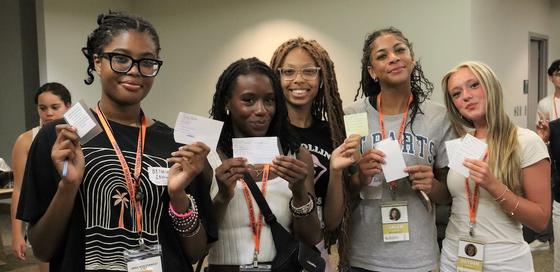George Mason University’s Jimmy and Rosalynn Carter School for Peace and Conflict Resolution hosted its largest group of high schoolers to date, 46, for its ninth annual Conflict Resolution Youth Summit in July.

Students came to George Mason’s Fairfax Campus from as far as Massachusetts, Texas, and China to participate in the four-day summit, which included a day trip to Washington, D.C., and 15 skill-building workshops designed to explore and address the various dimensions of conflict through mediation, negotiation, and collaboration.
The summit began with a workshop by James Coan from “More Like Us,” an organization dedicated to spreading the message that that Americans are more similar across the political spectrum than people realize. This workshop, titled “Defining the Perception Gap,” was aimed at fostering political depolarization and focused on engaging participants in meaningful dialogue about the misperceptions surrounding different political ideologies.
Following this, participants moved into the Carter School's bridge-building activities, which further challenged their perceptions, teamwork, and communication skills. These activities were instrumental in strengthening the group dynamics and enhancing their effectiveness throughout the summit.
The first simulation, known as the Portlandia Project, was conducted by Ryen Middleton, a graduate student from George Mason University’s College of Public Health. In this simulation, participants took on roles in a multi-stakeholder scenario addressing an environmental crisis affecting working-class communities, applying negotiation skills to meet diverse needs.

The simulation had a big impact on Olivia Ossa, a student at Thomas Worthington High School in Worthington, Ohio. “I loved the simulations,” Ossa said. “[The Portlandia Project] gave me the opportunity to experience negotiating and compromising, as well as getting a chance to play a crucial role in community building and forming connections with my teammates. I really enjoyed the Model UN vibes it gave and learned a lot from it!”
To illustrate the broad spectrum of conflict, the Carter School hosted two community artists. Sol O'Neill worked with participants to create two, 5-foot-tall Indigenous figures, symbolizing place and home for Virginia tribes, with influences from South American culture. Renowned artist and Mason Artist in Residence Abi Naanseh introduced participants to the traditional techniques of Arabic calligraphy through his mural "Mahaba and Salaam."
“Abi was fantastic. I learned a lot, and he was clearly very passionate about his work,” said Owen Simmons, from Osbourn Park High School in Manassas, Virginia.
On the final day, participants tackled the issue of human trafficking in collaboration with Freedom Connections, a group of Carter School students who work on issues surround human trafficking. They focused on identifying signs of trafficking and exploring resources to support affected individuals.
The summit concluded with the conflict capstone event, where participants applied their newly acquired skills to address issues identified by their peers. Their findings and solutions were presented to their families during the closing ceremony.
New for the summit this year, students were able to stay overnight in George Mason residence halls. This was important for the soon-to-be college-bound students, such as Eli Wike from Potomac Falls High School in Sterling. “My favorite part was probably getting to get a taste of college life through the experience,” Wike said.
Additional support for the summit was provided by George Mason’s Student Success Coaching, Facilities, and Mason Exhibitions.
Related News
- October 17, 2025
- September 17, 2025
- May 30, 2025
- April 21, 2025
- March 17, 2025
